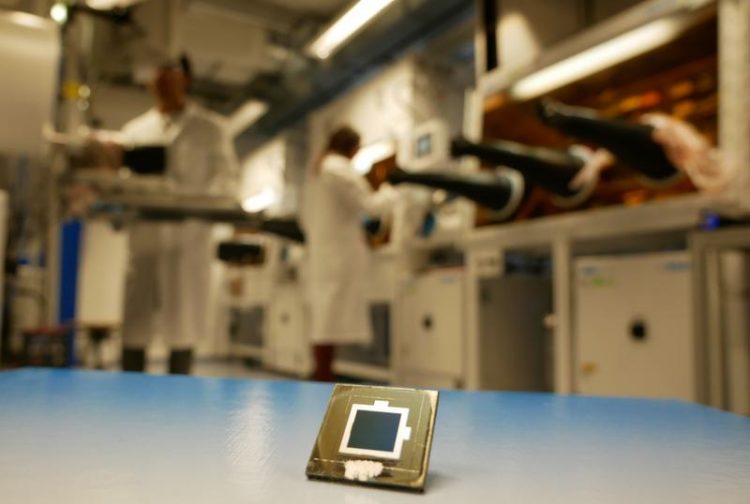World record for tandem perovskite-CIGS solar cell

Most of the work was done in the Helmholtz Innovation Lab HySPRINT at HZB. HZB
Perovskite-based solar cells have experienced an incredibly rapid increase in efficiency over the last ten years. The combination of perovskites with classical semiconductor materials such as silicon and copper-indium-gallium-selenide (CIGS) compounds in tandem solar cells promises low-cost, high-performance solar modules for the future. However, losses at the electrodes between the two semiconductors considerably reduce the efficiency.
HZB physicist Prof. Steve Albrecht and his team now successfully established novel electrode coatings that greatly reduce these losses.
They could produce a monolithic tandem solar cell from perovskite and CIGS that achieved an officially certified efficiency of 23.26 per cent, which currently is a world record value.
The tandem cell has an active area of one square centimetre and thus reaches another milestone, as perovskite CIGS tandem cells have so far been significantly smaller.
The contact layers consist of carbazole-based organic molecules coupled to phosphonic acid groups. These molecules arrange themselves into what are known as self-assembled monolayers (SAMs).
These SAMs have highly favourable electro-optical properties and the self-assembly even leads to complete coverage of rough semiconductor surfaces.
“The SAMs are strikingly simple and robust. This also allows them to be scaled up to industrial levels. In addition, they are compatible to a wide variety of substrates and their material consumption is extremely low”, explains Amran Al-Ashouri, PhD student in the Albrecht group and first author of the study.
This work might further accelerate progress towards extremely inexpensive perovskite-based PV technologies. The group has now filed two patents and is currently in licensing negotiations.
Prof. Steve Albrecht heads the Perovskite Tandem Solar Cells Junior Research Group funded by the German Federal Ministry of Education and Research (BMBF). Work on the perovskite solar cells took place primarily in the Helmholtz HySPRINT Innovation Lab, while the SAMs were developed in close collaboration with Kaunas University of Technology (Lithuania), where the group of Prof. Vytautas Getautis synthesized the molecules.
The CIGS layers are provided by the group of Dr. Christian Kaufmann, who heads the high efficiency CIGS activities at HZB and is supported by the SpeedCIGS project funded by the German Federal Ministry for Economic Affairs and Energy (BMWi).
Presentation on Wednesday, at EU PVSEC
Albrecht will present this work next Wednesday, September 11th, in Marseille at a plenary lecture of EU PVSEC, the world’s largest international photovoltaic and solar energy conference and exhibition.
Title of the talk: “Towards Highly Efficient Monolithic Tandem Devices with Perovskite Top Cells” S. Albrecht, A. Al-Ashouri, E. Köhnen, M. Jost, A. Morales, T. Bertram, L. Korte, B. Stannowski, C. Kaufmann, R. Schlatmann
Location: EU PVSEC, Marseille, France 9-13 September 2019
Date: Wednesday, September 11, 2019 PLENARY SESSION 3CP.1 from 10:30 – 12:00 Perovskite, Organic, CIGS and III-V Multi-Junction Devices
Media Contact
More Information:
http://www.helmholtz-berlin.de/All latest news from the category: Power and Electrical Engineering
This topic covers issues related to energy generation, conversion, transportation and consumption and how the industry is addressing the challenge of energy efficiency in general.
innovations-report provides in-depth and informative reports and articles on subjects ranging from wind energy, fuel cell technology, solar energy, geothermal energy, petroleum, gas, nuclear engineering, alternative energy and energy efficiency to fusion, hydrogen and superconductor technologies.
Newest articles

Skyrmions move at record speeds
… a step towards the computing of the future. An international research team led by scientists from the CNRS1 has discovered that the magnetic nanobubbles2 known as skyrmions can be…

A flexible and efficient DC power converter for sustainable-energy microgrids
A new DC-DC power converter is superior to previous designs and paves the way for more efficient, reliable and sustainable energy storage and conversion solutions. The Kobe University development can…

Technical Trials for Easing the (Cosmological) Tension
A new study sorts through models attempting to solve one of the major challenges of contemporary cosmic science, the measurement of its expansion. Thanks to the dizzying growth of cosmic…





















